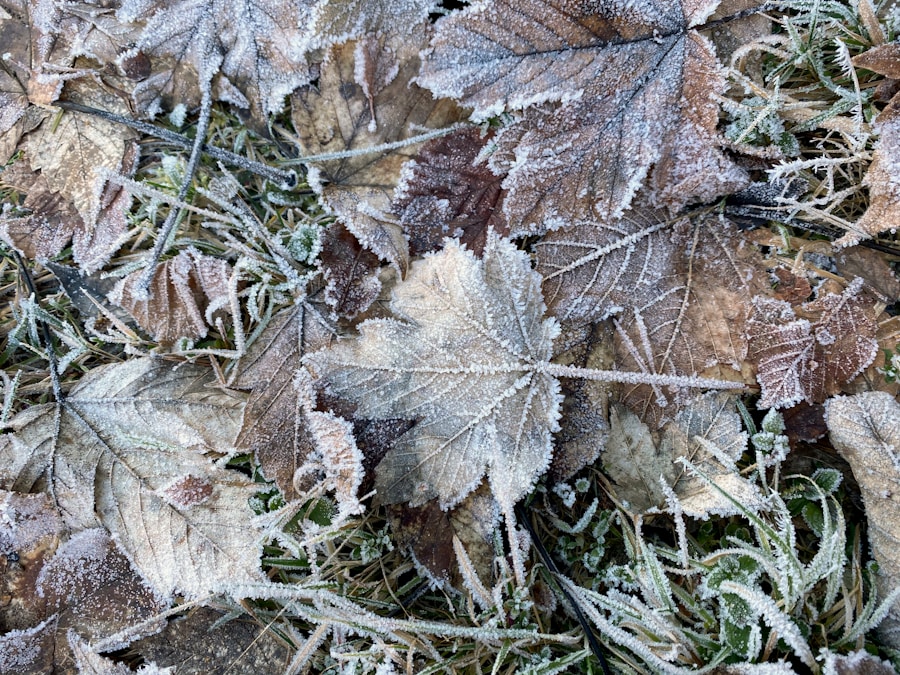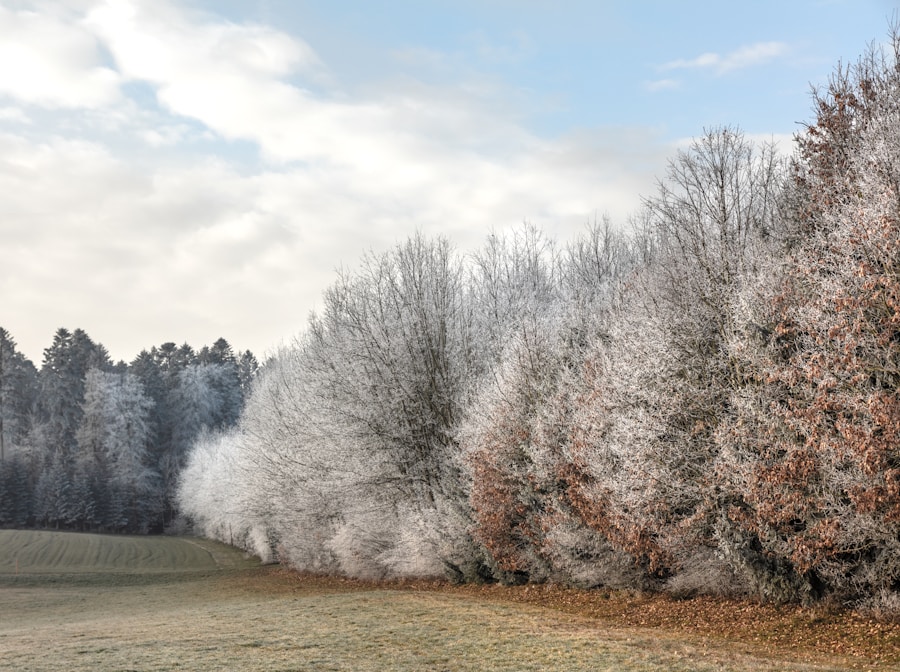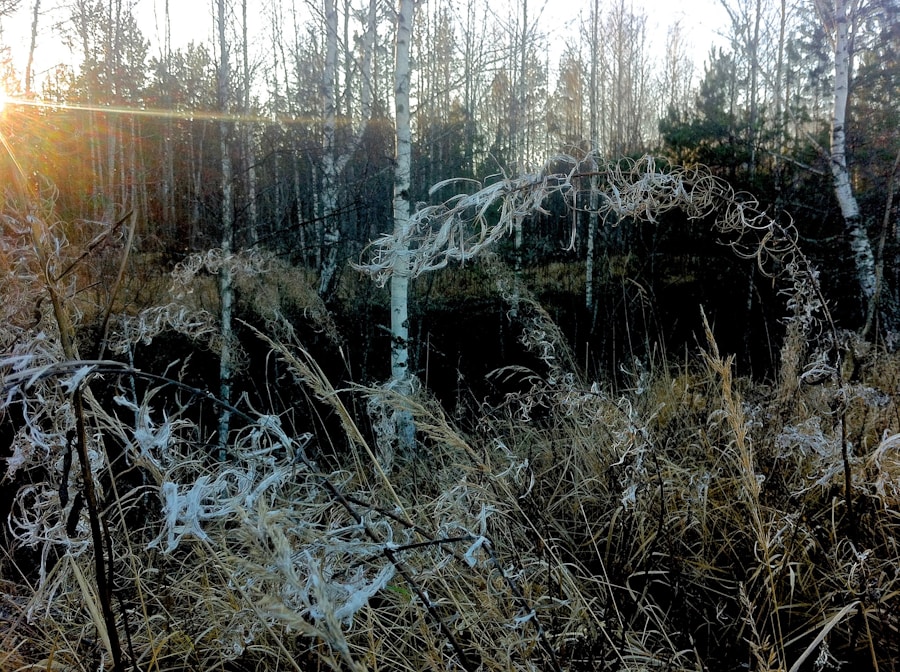Robert Frost’s poem “Stopping by Woods on a Snowy Evening” is a masterful exploration of the interplay between nature and human responsibility. Written in 1922, this poem encapsulates a moment of stillness and contemplation, inviting readers to pause and reflect on their own lives amidst the hustle and bustle of daily existence. The speaker finds himself at a crossroads, caught between the allure of the tranquil woods and the obligations that await him.
This tension between desire and duty resonates deeply with many, making the poem a timeless piece that speaks to the human condition. Frost’s ability to evoke vivid imagery through simple language allows readers to immerse themselves in the serene landscape he describes. The woods, blanketed in snow, serve as a metaphor for peace and introspection, contrasting sharply with the responsibilities that lie ahead.
The poem’s rhythmic quality, combined with its rich symbolism, creates a meditative atmosphere that encourages readers to consider their own moments of pause. In an age characterized by relentless activity and distraction, Frost’s work serves as a gentle reminder of the importance of taking time to reflect and appreciate the beauty around us.
Key Takeaways
- Frost’s “Stopping by Woods” invites readers to take a moment of pause and reflect on the beauty of nature.
- The poem’s setting and tone create a sense of tranquility and contemplation, drawing readers into the speaker’s experience.
- The speaker’s contemplation and reflection on the woods and the owner’s absence reveal a deeper sense of longing and introspection.
- Themes of nature, solitude, and the passage of time are symbolically represented in the poem, inviting readers to ponder their own lives.
- “Stopping by Woods” continues to impact readers with its timeless message of the importance of taking a moment of pause in today’s busy world.
Analysis of the Poem’s Setting and Tone
The setting of “Stopping by Woods on a Snowy Evening” is integral to its overall impact. Frost paints a picture of a quiet, snow-covered landscape that invites contemplation. The woods are described as “lovely, dark and deep,” suggesting both beauty and mystery.
This duality in the setting reflects the speaker’s internal conflict; while the woods represent a serene escape from the demands of life, they also evoke a sense of foreboding. The stillness of the scene contrasts with the speaker’s obligations, creating a palpable tension that permeates the poem. The tone of the poem is contemplative and reflective, underscored by a sense of longing.
As the speaker pauses to admire the woods, there is an almost reverent quality to his observations. The gentle falling snow and the quietude of the evening create an atmosphere conducive to introspection. However, this tranquility is tempered by the speaker’s awareness of his responsibilities, as indicated by the repeated refrain about having “promises to keep.
Examination of the Speaker’s Contemplation and Reflection

The speaker’s contemplation in “Stopping by Woods on a Snowy Evening” is central to understanding the poem’s emotional resonance. As he stands before the woods, he is not merely observing nature; he is engaging in a profound moment of self-reflection. The act of stopping itself becomes a metaphor for taking stock of one’s life and choices.
In this moment, he grapples with his desires and responsibilities, weighing the allure of the peaceful woods against the obligations that await him. Frost captures this internal struggle through the speaker’s thoughts and feelings. The woods symbolize a retreat from societal expectations, offering a space for solitude and contemplation.
Yet, as he gazes into the depths of the forest, he is acutely aware that he cannot remain there indefinitely. The repetition of “promises to keep” serves as a reminder of his commitments, grounding him in reality even as he yearns for escape. This tension between desire and duty reflects a universal human experience—one that resonates with anyone who has ever felt torn between personal aspirations and societal obligations.
Discussion of the Poem’s Themes and Symbolism
“Stopping by Woods on a Snowy Evening” is rich with themes that explore the complexities of life, including nature versus civilization, duty versus desire, and the passage of time. The woods themselves serve as a powerful symbol within this framework. They represent not only beauty and tranquility but also the unknown—an invitation to explore deeper aspects of existence that often go unexamined in daily life.
The snow-covered landscape evokes purity and stillness, suggesting that moments of pause can lead to clarity and insight. Another significant theme in the poem is the tension between obligation and freedom. The speaker’s acknowledgment of his “promises” highlights the weight of responsibility that often accompanies adulthood.
While he is drawn to the peacefulness of the woods, he ultimately recognizes that he must return to his commitments. This duality reflects a broader commentary on modern life; many individuals find themselves caught in a cycle of work and obligation, often neglecting their own needs for reflection and rest. Frost’s portrayal of this struggle encourages readers to consider their own lives and the balance they strike between their desires and responsibilities.
Exploration of the Poem’s Impact and Legacy
The impact of “Stopping by Woods on a Snowy Evening” extends far beyond its initial publication. It has become one of Frost’s most celebrated works, frequently anthologized and studied in academic settings. Its themes resonate with readers across generations, prompting discussions about the nature of existence, personal responsibility, and the importance of taking time for oneself.
The poem’s accessibility—both in its language and its themes—has contributed to its enduring popularity. Moreover, Frost’s work has influenced countless poets and writers who have sought to capture similar moments of introspection in their own writing. The simplicity of his style belies the depth of meaning within his verses, inspiring others to explore complex emotions through straightforward language.
The poem has also found its way into popular culture, appearing in various forms of media and often cited in discussions about mindfulness and self-care. Its legacy continues to inspire individuals to seek moments of pause amidst their busy lives.
The Significance of Taking a Moment of Pause in Today’s Busy World

In today’s fast-paced world, where distractions abound and responsibilities often overshadow personal well-being, Frost’s “Stopping by Woods on a Snowy Evening” serves as a poignant reminder of the value of taking a moment to pause. The poem encapsulates a universal truth: that amidst our obligations, it is essential to carve out time for reflection and appreciation of life’s beauty. As we navigate our daily routines filled with commitments and deadlines, Frost’s work encourages us to embrace stillness as an opportunity for clarity.
The significance of pausing resonates deeply in contemporary society, where mindfulness practices have gained traction as tools for managing stress and enhancing well-being. By reflecting on Frost’s imagery and themes, individuals can find inspiration to prioritize moments of quiet contemplation in their own lives.
In essence, Frost’s poem not only captures a fleeting moment but also invites us to consider how we can integrate such moments into our own lives for deeper understanding and connection with ourselves and our surroundings.
If you enjoyed Robert Frost’s contemplative poem “Stopping by Woods on a Snowy Evening,” you may also appreciate the article Indian Aesthetics: Exploring the Nature, Philosophy, and Multifaceted Functions of Art. This article delves into the deep connections between art and nature, much like Frost’s poem explores the beauty and tranquility of the winter landscape. Both works invite readers to pause and reflect on the world around them, finding moments of peace and inspiration in the natural world.























+ There are no comments
Add yours